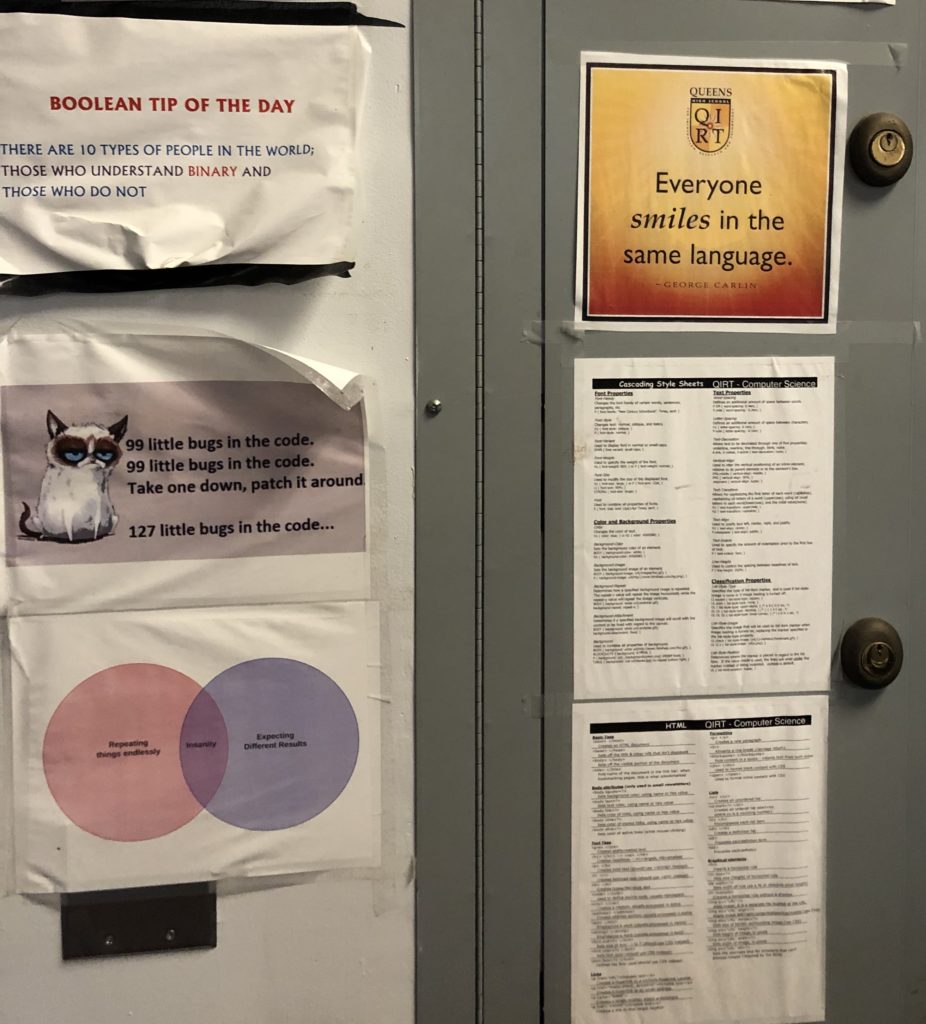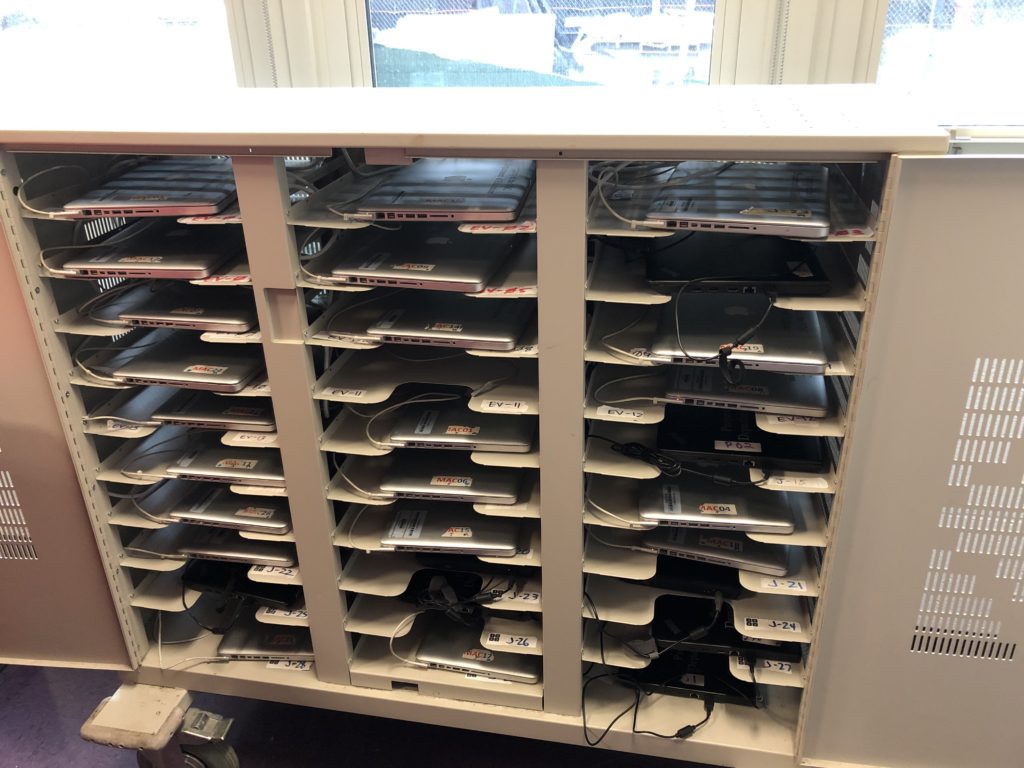On a Friday afternoon in early March, two students in Jeff Kaufman’s Advanced Placement Computer Science Principles class at the Queens High School for Information, Research and Technology had only one thing on their minds: reports that the coronavirus, still strange news to many in the country, had arrived in New York.
“There’s one in Manhattan. There’s 19 in Westchester,” said QIRT junior Joseph Miceli, known to students and teachers alike as Joey. He had a map of coronavirus cases up on his computer screen.
Angel Basillo, also a junior, replied, “Yea, China has the most, though.”
“I mean,” Joey said, “Alaska doesn’t have anybody, so we’re good there.”
Joey and Angel take computer science courses at QIRT, a high school deep in the Far Rockaways of Queens, through CS4All, an $80 million public-private partnership sponsored by New York City’s Department of Education. The goal of CS4All is to foster greater participation of New York’s traditionally underrepresented students, many of whom are students of color, in computer science classes.
The students at QIRT are in many ways the ideal recipients of a CS4All education. Eighty-nine percent of students there are black or Hispanic, and nearly 70% qualify for free lunch, according to Department of Education data.
But this year QIRT, like so many schools in New York City and across the country, is adjusting to the Covid-19 pandemic that has shuttered schools and prompted a widespread move to virtual instruction.
On Sunday, March 15, Gov. Andrew Cuomo and Mayor Bill de Blasio announced the school closings effective the following day. In a note of candor, Chancellor Richard Carranza acknowledged that the city’s Department of Education was “flying the plane as we’re building the plane.”
The decision meant the end of in-school computer science instruction for students like Joey and Angel, and necessitated a massive, unprecedented transition to online teaching for students and teachers in a matter of days. Left scrambling, students and teachers are charting an uncertain path while also striving to maintain some semblance of continuity in their day to day lives.
“I’m not changing anything,” Kaufman said. “They’re going to have the same lessons I’ve always given them.” He said he’s been provided several free programs, like Code Combat, an instructional coding video game, that can engage students at home. “I’ll let the kids choose what they want to do, and as long as they do something, I’ll grade them for it.”
With classwork and exams now conducted entirely online and school attendance in flux, the reach and success of initiatives like CS4All is at risk, given that the program faced challenges in adapting curriculum and engaging students even in the best of times.
In an interview in his classroom prior to school closures this spring, Kaufman emphasized the importance of accessibility in teaching his computer science students. “It’s not the curriculum, but the way it’s presented,” he said. “How do you present this stuff so it’s understandable and also engaging?” When you have “reach and the numbers don’t change, something is going on. Either it’s my teaching or the curriculum.”
It’s a sentiment echoed by Aankit Patel, now the director of STEM Education Programs at CUNY and previously one of the designers of the patchwork CS4All curriculum. A large part of the CS4All program was, in the language of the Department of Education, “professional development,” or empowering teachers with the tools, training and guidance they need to teach computer science.
But when they first designed and implemented CS4All, Patel said, they saw that “The model didn’t work for teachers at those low performing schools. That’s a huge equity issue. We can talk a lot about demographics, but if we’re leaving out the schools that already struggle, they’re likely to struggle with CS but it didn’t seem like an excuse.”
Two years into implementation, an independent study conducted by the Research Alliance for New York City Schools in May 2018 found that while the CS4All program was making inroads into high-needs, traditionally underrepresented schools, there were still “demographic disparities” found within New York’s computer science classes.
Female students and students of color, along with English language learners and students who qualified for free lunch, were less likely to even take computer science classes, let alone succeed in them.
In this respect, QIRT is in many ways an outlier. Students like Joey and Angel remain engaged in the coursework, motivated both by Kaufman and their own interest in technology and computing. “Anywhere you can think of technology, I’m interested,” Joey said in class before schools closed. “In 2120, technology is only going to be more important,” he continued. “People are so worried that they’re going to take our jobs, but like, no, people will still be needed.”

Though he’s a social studies teacher by training, Kaufman has taken an active role in ensuring his students are prepared for his computer science classes, especially after the beginning of virtual instruction. He had even flown to Portland, Oregon in March to attend a computer science education conference that was consequently cancelled due to the coronavirus outbreak.
Now, with in-person gatherings limited in New York City, professional development is essentially on hold. Before schools closed, an internal Department of Education presentation instructed teachers to use allotted time to prepare for virtual instruction. And with face-to-face teaching a luxury of the past, computer science students like Joey and Angel are, with help from Kaufman, figuring out their own way forward.
Students are also turning to new, online sources of knowledge. “YouTube has been a great help,” Joey said. “There’s a series called CrashCourse, it’s been a great help. Basically, just looking up stuff I don’t know.”
Angel mentioned that Khan Academy, a non-profit that produces instructional videos online for a variety of courses, has been useful as well. Unlike many of New York’s students, they have access to the internet, computers and cell phones at home. Joey said he’s been able to use two phones while he works at home – one open to Google Classroom, and the other to look up videos or PowerPoints – and Angel uses a computer to complete assignments.
They appreciate that Kaufman, like other teachers at QIRT, has trusted the students to work on their own time and craft their own flexible schedules. In some instances, faculty at QIRT have taken to providing a week’s worth of assignments upfront and allowing the students to work at their own pace for two or three days at a time.
Kaufman, they said, is available for office hours via Zoom, the online video conferencing service, and the students remain engaged using Google Classroom, where they can access course assignments and tutorials. “It’s a little more difficult,” Angel said of his computer science class, “but I think I can still do it.”

In a typical year, Joey, Angel and other AP Computer Science students across New York City would provide a portfolio of their computer science work, as well as sit for multiple choice questions, as part of their final examinations.
This year, however, the exam will be different, since students will be taking it at home. The College Board announced that there will be no multiple choice section, but that the grading of portfolio assessments, like exams and projects, will remain unchanged since these components are comprised of at-home work anyways.
When Kaufman first introduced the AP Computer Science class, he had all the students take the end-of-year exam. But he felt “terrible” because so many of the students received a “1” on the test, the lowest score possible. Now, he only administers the exam to students who he thinks have a chance of passing, like Joey and Angel.
Kaufman said the College Board had floated the idea of allowing the multiple choice section to be taken at home but worries over cheating ultimately prompted the cancellation of that part of the exam. “There are ways to do it with Chromebooks,” Kaufman said. “If I had a complete set of Chromebooks I could prevent cheating, but it still wouldn’t prevent collaboration. So they gave that up.”
Kaufman also said that he had spent most of his curriculum preparing students for the multiple choice questions. “The problem with dumping the multiple choice questions is that I spend three-quarters, maybe more than that, maybe seven-eighths of the course,” he said, “on material that they need for the multiple choice exam. It’s a very difficult decision that they had to make.”
For now, Joey and Angel are completing their work and biding their time until further guidance on when schools might open, if at all, this year. No change, at least yet, has been made to the date when they’re due to submit their portfolio of computer science work to the College Board on May 26.
“Nobody knows what to expect,” Joey said. “It’s just like, let’s see how this goes now.”



